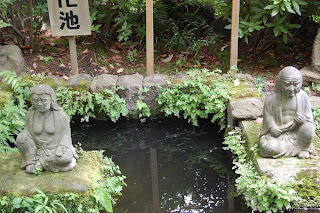

Sustainable School Food - A Full Circle
Osaki City boasts two school food centers that supply student lunches with food grown and prepared locally, with plans to add another food center in southern part of the city. To promote their food centers, Osaki City invites visitors from other school districts to observe how healthy and nourishing food can be prepared and delivered at a low cost to the students. The Tajiri Jr. High School Food Center tries to use locally grown food whenever possible; over 50 % of the vegetables including Japanese radish, mushrooms, spinach and lettuce are grown locally and 100 % of the rice is harvested from nearby fields. A JFMF teacher asked our hosts if “ a student looked out the window at the rice fields and wondered “ Am I eating rice that has been grown in that field?” the answer would be yes! In addition, the local food shed provides ham sausages, miso, soy sauce, and tofu.
All the food at Tajiri is prepared on site in a large facility, where food service workers use state of the art machinery to chop, cook and clean. For example, a computerized thermometer is used to check for food temperature in the large vats of Miso soup. However, the human touch is not forsaken; industrial sized ladles are hand stirred to mix the ingredients and the head chef meticulously tastes each step in the food’s preparation where she carefully adjusts the flavors.
Choice of menu is not an option for Tajiri Jr. High school students as everyone eats the same thing. Twice each year, students get to choose their dessert from two options. The only exception to this uniformity is for students with allergies. At Tajiri Jr. High, thirteen students have been diagnosed with an allergy and these students claiming allergies must have a doctor’s note to verify it. The allergies seen in the Tajiri district include allergies to egg, milk and kiwi fruit. Traditionally in the Japanese culture, food substitutions and preferences are not a common practice.
The waste from the food preparation does not end up at the landfill. Instead, the wastes get recycled into compost. The amount is so large that the waste is collected and then transported to a composting facility, which is managed and operated by local farmers, not the municipality. Some of the composted material is then returned to the schools and used in the school’s flower and vegetable gardens.
All students pay for lunch – there are no free lunch programs. According to the authorities, there is no need for free lunches as all families can afford to pay.
The cost for a school lunch each day at Tajiri Jr. High is 299 yen, which roughly equates to $2.99. The cost is slightly less at the elementary school 242 yen and the Kindergarten program 221 yen. Once the food is prepared and ready to be eaten, the students leave their classrooms, don their clean white frocks and hats and come to the food center to retrieve their lunch. Each portion of the lunch is carried in large communal vats. The students carry the heavy food containers back to their classroom where the students take turns serving themselves efficiently from a line. Students eat at their desks with their teacher. The atmosphere is loud and jovial and the students joke and laugh with the teacher. After everyone has eaten the students proceed to clean up the dishes; nothing is made from disposable materials save for the milk cartons which are carefully folded and compacted before being put in the small plastic garbage bag. The students scrape their plates into the compost bucket. Students bring their own chopsticks from home and the rest of the dishes are sent back to the kitchen to be cleaned for the next day. The lunch that I shared with the Tajiri Jr. High school students was both delicious and filling. Obesity and malnutrition do not exist at this Japanese school.




















